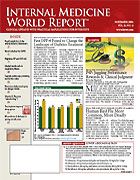Publication
Article
The Higher the Nighttime BP, the Greater the Risk of CHF
Author(s):
Ambulatory Superior to Office Measurement
Older men whose blood pressure (BP) increases or does not decrease at night are more than twice as likely to develop congestive heart failure (CHF) as men whose BP decreases during the night, based on a Swedish study of almost 1000 elderly men.
Hypertension is considered the most important risk factor for CHF, and patients with CHF often have less variation in circadian BP patterns than individuals without CHF. But the relationship between abnormal day–night BP patterns and the risk of future CHF events has been uncharted territory until now.
JAMA
This prospective, community-based, observational cohort study (. 2006; 295:2859-2866) recruited 951 elderly men without CHF, valvular disease, or left ventricular hypertrophy. At study entry (years 1990-1995), the men underwent 24-hour ambulatory BP monitoring, in addition to office-based BP measurements.
By the end of 2002, 70 men had developed CHF (incidence rate, 8.6 per 1000 person-years at risk). After adjusting for antihypertensive drug use and baseline CHF risk factors, nighttime ambulatory diastolic BP and nondipping emerged as significant, independent predictors of CHF.
Each 5-mm Hg increase in nighttime ambulatory diastolic BP resulted in:
• 21% overall (unadjusted) increased risk for CHF
• 13% to 25% increased risk for CHF after adjusting for confounders
• 2.7 more cases of CHF per 1000 person-years at risk.
When office-based BP measurements were factored in to the analysis, non­dipping remained a significant predictor of CHF, but ambulatory nighttime diastolic BP did not.
Erik Ingelsson, MD, PhD, Uppsala University, Uppsala, Sweden, and colleagues noted that this suggests that nighttime BP levels may be an important indicator for CHF. Their results suggest that nighttime BP may provide additional information about a patient’s risk for CHF that is not captured by BP measurement in the office setting.
IMWR
“Being the first study regarding diurnal BP pattern and risk for CHF in a community-based setting, one cannot expect it to change the praxis for treatment on a larger scale,” Dr Ingelsson told . Nevertheless, he said, the study “shows the importance of diurnal BP patterns for CHF risk, and it also adds to prior studies that ambulatory BP measurement seems to be superior to office BP measurement in predicting cardiovascular risk.”
He said that “a good case can be made for using this technique in patients in whom hypertension has been newly diagnosed by means of clinic BP measurements,” noting that “nighttime BP can be assessed only with ambulatory BP monitoring, and non­dipping has previously been shown to also be a risk factor for other cardiovascular diseases.”
However, Dr Ingelsson went on to observe that “since those patients are rather rare in the population, the cost–benefit ratio for searching for them must be evaluated before recommending ambulatory BP measuring on a larger scale.” He added that interventional trials are needed to determine whether treating “nondippers” offers a clinical benefit.
Key points
• Ambulatory BP measurement is superior to office measurement in predicting CHF risk.
• Consider asking your patients at high risk of CHF to monitor their BP at night.






